World Investment Forum 2023 session on the investment, trade and development nexus
Your Excellency, Mr. Thani Al Zeyoudi, Minister of State for Foreign Trade of the United Arab Emirates,
Your Excellency, Mr. Mmusi Kgafela, Minister of Trade and Industry of Botswana,
Your Excellency, Mr. Bernardo Ivo Cruz, Secretary of State for International Investment and Foreign Trade of Portugal,
Distinguished guests,
Ladies and Gentlemen,
It is a great pleasure to open this session on the trade, investment and development nexus.
Trade and investment are part of the same engine that has propelled the rise and expansion of the modern system of global production: global value chains or GVCs.
Today, about 80 per cent of global trade takes place within the international production networks of multinational enterprises, which in turn, are the protagonists behind global foreign direct investment.
The number shows the extent to which the expansion of global value chains has relied on the synergies between trade and investment. In fact, it is one of the most cited figures from UNCTAD.
GVCs can spread value added, employment and technologies across countries at different stages of development. They can accelerate the “catch-up” of developing countries and lead to greater convergence between economies.
Over the last decades, developing countries have increasingly participated in global value chains: Their share in global value-added trade increased from 20 per cent in 1990 to over 40 per cent today.
Yet many of the poorest countries are still struggling to gain access to GVCs, beyond exporting their natural resources.
Development benefits of global value chains are not automatic.
A priority for developing countries, and least developed countries in particular, is to embark on a path in which participation in global value chains enhances opportunities for countries to grow and capture value-added for their domestic economy.
This has always been the top priority but the context in which this is happening has been changing and is different now.
I want to highlight some of these changes.
One: Cross-border flows of capital, goods, services and technology in global value chains have evolved.
Until about 2010, FDI and international trade grew in tandem boosting a system of international production. After 2010 and the global financial crisis, both experienced a slowdown.
But while trade kept pace with GDP growth, FDI lost track. And in this new decade, FDI has been on a downward trajectory.
The evolution of FDI is no good news as economic growth has always depended on investment, and FDI has been a critical source of finance for many developing countries.
Two: The shifts in terms of types of flows suggest that globalization has become much less tangible.
Investment in physical assets has slowed down most; trade in goods is growing slightly; trade in services much more, and cross-border payments for intellectual property much much more. And flows of data are growing by a multiple.
Three: There is a possible trend towards less internationalization.
The system of international production has come under severe pressure with risks of a retreat of global value chains, but with possible growth of regional value chains and reshoring.
And four: Sustainability has become a paramount concern.
With climate change and rising temperatures, sustainability and the energy transition, in particular, are increasingly considerations for investment decisions.
Also, in the United Arab Emirates – our host this week. The UAE is boosting the energy transition by investing in technology that allows tapping the potential of its wind and solar energy.
From a development perspective, many of these shifts imply a shrinking pool of investment in physical assets, pressure on value capture from GVC activities, and changes in drivers and determinants of international production. Often, these shifts can have a negative effect on the chances of developing economies to “climb” the GVC development ladder.
But the transformations also offer new and many opportunities: Opportunities arising from new regional value chains, smaller and more distributed manufacturing activities, or the diversification of value chains to enhance resilience.
Ladies and Gentlemen,
A trade and investment development alliance for the next decade must be driven by the objective to maximize sustainable development impacts and minimize negative side effects of the ongoing transformations in global production.
We must foster such an alliance with dialogue and exchanges. By hosting the World Investment Forum, the COP 28 and the 13th Ministerial Conference of the WTO, the UAE provides a very valuable space for discussions that we need to harness.
And policymakers need to leverage these opportunities with supportive and coherent trade and investment poIicies.
In our discussion today, I would like to focus on precisely these aspects:
- How the role of international trade and investment in development and industrial strategies is changing;
- How countries on the first steps of the GVC development ladder can still reap the benefits of export-led and investment-driven growth;
- What the implications of the multiple crises are;
- How to boost supply chain resilience, and what the implications of political fragmentation for trade and investment policies are; and
- How international organizations such as UNCTAD and the WTO can assist developing economies with these challenges.
We have the privilege to have with us today leading global experts, policymakers and the excellence of the business community. Let us not miss the opportunity of today's discussions to strengthen the development alliance between trade and investment.
I wish you a successful meeting.


